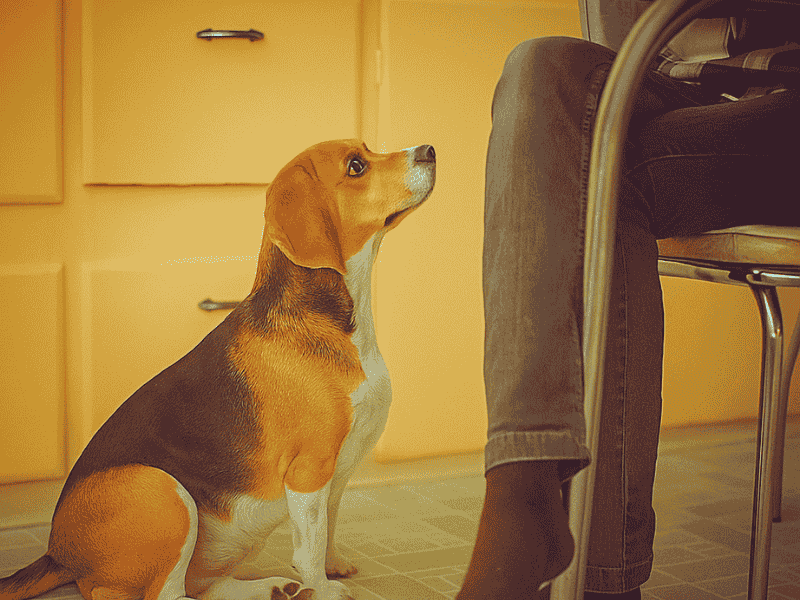Dog begging is one of the most common behaviors pet owners deal with daily. Picture this: You’ve just sat down for dinner after a long day. The aroma of your meal fills the room. Suddenly, you feel it—those big, soulful eyes locked onto your plate. Your furry friend sits perfectly still, head tilted, maybe even letting out a soft whine. Sound familiar?
If you’ve ever given in to those puppy dog eyes, you’re not alone. However, what starts as an occasional treat can quickly become a frustrating habit. The good news? You can fix this behavior with the right approach and consistency.
In this guide, I’ll walk you through everything you need to know about why dogs beg, when it becomes problematic, and most importantly, how to stop it for good. Let’s dive in.
What is dog begging?
Dog begging happens when your pet persistently seeks food or attention from you during mealtimes. Moreover, it’s not just about staring. Dogs have perfected an entire arsenal of tactics to get what they want.
Common begging behaviors include:
- Intense staring with those irresistible puppy eyes
- Whining or soft barking near the table
- Pawing at your leg or nudging your hand
- Drooling excessively when food is present
- Following you around the kitchen
- Jumping up to get closer to your plate
Interestingly, begging isn’t limited to food. Some dogs beg for toys, playtime, or walks using similar tactics. However, food begging remains the most common issue pet owners face.

Why Do Dogs Beg for Food?
The Science Behind the Behavior
Understanding why dogs beg starts with biology. First, dogs have an incredible sense of smell—about 100,000 times stronger than ours. Consequently, they can detect the aroma of your dinner from across the house. To them, ignoring that smell is nearly impossible.
Furthermore, begging is rooted in survival instincts. Wild dogs and wolves are natural scavengers. They learned to eat whenever food was available because their next meal wasn’t guaranteed. Therefore, even well-fed dogs still carry this opportunistic eating instinct.
It’s a Learned Behavior
Here’s the truth: dogs repeat behaviors that work. When begging gets them food, they remember that success. Subsequently, they’ll try again and again.
Think about it this way. Maybe you gave your puppy a small piece of chicken once. Perhaps a guest slipped them some food under the table. Either way, your dog learned a powerful lesson: begging equals rewards.
Additionally, intermittent reinforcement makes this worse. If begging works sometimes but not always, dogs become even more persistent. They’ll keep trying because they know it might pay off eventually.
Why Dogs Beg Even After Eating
Many owners wonder why their dogs beg despite having just finished their own meal. The answer is simple: their scavenging instinct doesn’t turn off when they’re full.
Moreover, your food simply smells more appealing than their regular kibble. Human food contains fats, seasonings, and aromas that dogs find irresistible. Therefore, they’re not necessarily hungry—they just want what you’re having.
When Does Begging Become a Problem?
Some begging is natural. Puppies exploring their environment will show interest in what you’re eating. Occasional curiosity isn’t a concern. However, persistent begging creates real problems.
Health Concerns You Should Know
First and foremost, table scraps contribute to obesity in dogs. Just like humans, excess calories lead to weight gain. Furthermore, obesity triggers serious health issues including diabetes, joint problems, and heart disease.
Additionally, many human foods are toxic to dogs. Chocolate, grapes, onions, and garlic can cause severe illness or even death. Even seemingly harmless foods like fatty meats can trigger pancreatitis—a painful and potentially life-threatening condition.
Veterinarians recommend that 90% of a dog’s calories come from balanced dog food. Treats and extras should never exceed 10% of their daily intake. Therefore, regular table scraps quickly disrupt this balance.
Behavioral Issues That Develop
Beyond health, begging creates behavioral problems. Dogs who successfully beg become pushier over time. What started as cute whining can escalate to demanding barks or even food aggression.
Moreover, constant begging disrupts family meals. You can’t enjoy dinner peacefully with a dog constantly pawing at you. Guests may feel uncomfortable or annoyed. In severe cases, dogs become tripping hazards as they follow you around the kitchen.
Perhaps most importantly, begging teaches dogs to ignore boundaries. This undermines other training efforts and affects your overall relationship with your pet.
How to Stop a Dog From Begging
Now for the practical part—stopping this behavior. The good news is that with consistency and patience, you can train any dog to stop begging. Let me share the most effective methods.
Prevention is Your Best Strategy
The golden rule: never feed your dog from your eating area. This applies to everyone in your household. No exceptions, no “just this once.” Context matters tremendously to dogs. When they learn that your dining table equals food for them, begging becomes automatic.
Additionally, consider physical barriers. Baby gates work wonderfully to keep dogs out of the dining room during meals. Alternatively, you can use a crate or playpen. Initially, this might seem harsh. However, you’re actually helping your dog by removing temptation and setting clear boundaries.
Feed Your Dog First
Here’s a simple but effective trick: feed your dog right before you eat. Give them their meal in a completely different room from where you dine. Consequently, they’ll be busy eating their own food while you enjoy yours.
Furthermore, a full stomach reduces their motivation to beg. They’re less likely to pester you when they’ve just finished their own satisfying meal.
Keep Your Dog Occupied
One of my favorite methods involves giving dogs something better to do. Food puzzle toys work brilliantly for this purpose. A Kong stuffed with frozen peanut butter can keep a dog entertained for 20-30 minutes—plenty of time to finish your meal.
Other excellent options include:
- Lick mats spread with wet dog food
- Puzzle toys that dispense kibble when moved
- Long-lasting chews like bully sticks
- Interactive treat balls
The key is timing. Give your dog their toy right when you sit down to eat. This redirects their focus from your plate to their own entertainment.
Teach the “Go to Your Spot” Command
Training your dog to settle on a mat or bed during meals changes everything. Start by choosing a designated spot—maybe a dog bed or mat near (but not right next to) the dining table.
Practice this command outside of mealtimes first. Lead your dog to their spot, ask them to lie down, and reward them with treats. Gradually increase the time they stay there before getting a reward.
Once they understand the concept, use this during meals. Initially, reward them every few minutes for staying put. Over time, you’ll only need to give treats at the beginning and end of your meal. Eventually, they’ll settle automatically when you sit down to eat.
The Power of Ignoring
Sometimes the best response is no response. If your dog begs, completely ignore them. No talking, no eye contact, no pushing them away—absolutely nothing.
However, be prepared for what trainers call an “extinction burst.” When a previously successful behavior stops working, dogs try harder before giving up. Your dog might whine louder, paw more insistently, or even bark. This is normal and actually shows your training is working.
The critical part? Don’t give in during this phase. If you break down when they escalate, you’ve taught them that pushing harder gets results. Stay strong, and the behavior will fade.
How to Prevent Puppy Begging
Prevention is infinitely easier than correction. If you have a puppy or recently adopted dog, start with good habits from day one.
Establish a strict no-feeding-from-the-table rule immediately. What seems cute in an 8-week-old puppy becomes annoying in a 60-pound adult dog. Therefore, consistency from the start saves you headaches later.
Feed your puppy in a separate area before family meals. Use gates or a playpen to create physical boundaries. Additionally, provide appropriate toys to keep them occupied during your mealtimes.
Most importantly, educate everyone in your household. Children especially need to understand the rules. One person sneaking food under the table can undo weeks of training.
Mistakes to Avoid
Never Give In “Just This Once”
The biggest mistake owners make? Inconsistency. Giving in occasionally creates intermittent reinforcement—the most powerful type of learning. When begging works sometimes, dogs become more persistent, not less.
Don’t Punish or Scold
Yelling at your dog for begging is counterproductive. Even negative attention reinforces the behavior because dogs prefer any attention over being ignored. Furthermore, punishment damages trust and doesn’t address the root cause.
Instead, focus on positive reinforcement. Reward the behaviors you want (lying quietly on their bed) rather than punishing behaviors you don’t want.
Can You Ever Share Food With Your Dog?
Yes, but with important guidelines. If you want to share dog-safe foods, wait until after you’ve finished eating. Then, put the food in your dog’s bowl in their regular feeding area—never from the table.
Safe options include plain cooked chicken, carrots, apples (without seeds), and green beans. However, avoid fatty meats, seasoned foods, and anything toxic to dogs.
Remember the 90/10 rule: regular dog food should provide 90% of calories, with treats and extras making up no more than 10%. This maintains proper nutrition while allowing occasional special treats.
Dogs begging is a learned behavior that you can unlearn with patience and consistency. The key lies in understanding why it happens and addressing the root cause rather than just the symptoms.
Start by preventing access to human food areas. Feed your dog before your meals. Keep them occupied with toys and puzzles. Teach alternative behaviors like settling on a mat. Most importantly, never reward begging—not even once.
Yes, those puppy eyes are hard to resist. However, giving in creates problems that affect your dog’s health, behavior, and your quality of life. Therefore, staying firm ultimately shows more love than caving to every plea.
With commitment from your entire household, you’ll soon enjoy peaceful, beg-free meals. Your dog will be healthier, better behaved, and just as loved—maybe even more, because you’re providing the structure and boundaries they need to thrive.
Frequently Asked Questions
Why do dogs beg even after eating their own food?
Dogs beg after eating because their scavenging instinct remains active regardless of hunger. Your food smells more appealing than their kibble, triggering their natural desire to eat whenever food is available.
How long does it take to stop a dog from begging?
Most dogs show improvement within 2-4 weeks of consistent training. However, dogs with deeply ingrained begging habits may take longer. Consistency from all family members is crucial for success.
Is it okay to give my dog table scraps occasionally?
Small amounts of dog-safe foods are fine if given in their bowl after meals, not from the table. Never exceed 10% of their daily calories from treats or human food.
What if my puppy begs constantly?
Puppy begging is easier to prevent than fix. Never feed from eating areas, use physical barriers during meals, and provide appropriate toys. Early consistency prevents adult begging problems.
Should I ignore my dog when they beg?
Yes, complete ignoring works effectively. However, combining it with alternative activities like puzzle toys or teaching “go to your spot” produces faster, less stressful results for both you and your dog.

